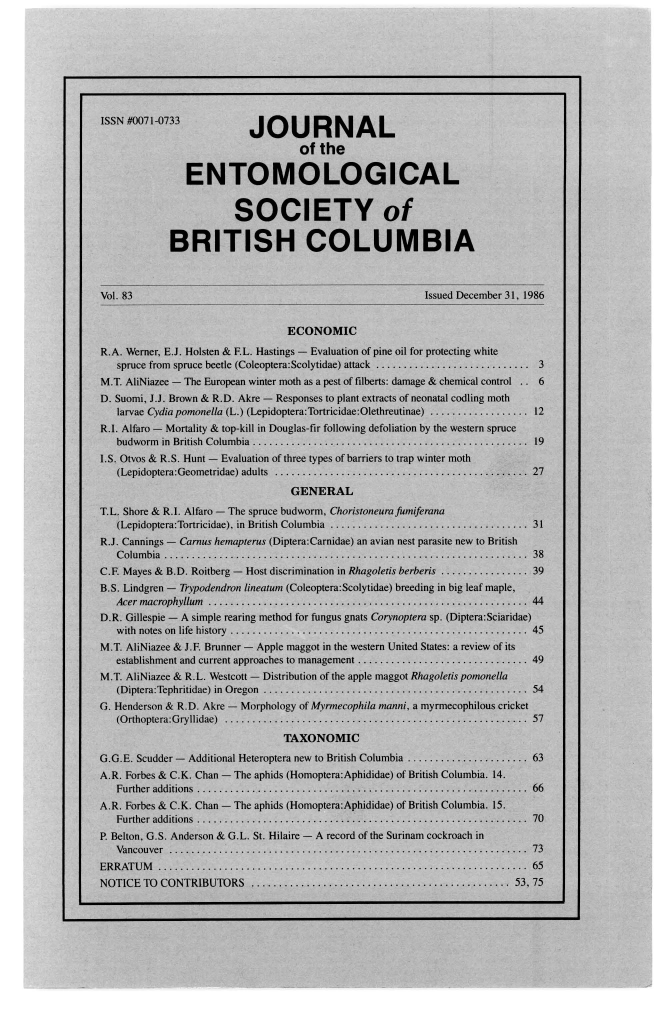Mortality and top-kill in Douglas-fir following defoliation by the western spruce budworm in British Columbia
Keywords:
western spruce budworm, <i>Choristoneura occidentalis</i>, Douglas-fir, <i>Pseudotsuga menziesii</i>Abstract
Surveys of mortality and top-kill caused by the western spruce budworm, <i>Choristoneura occidentalis</i> Freeman, in 65 stands of Douglas-fir, <i>Pseudotsuga menziesii</i> (Mirb.) Franco are reported. Top-kill was detected in 85% of the stands and 25% of the trees surveyed. Mortality amounted to 8% and less than 1% of the trees examined in the Vancouver and Kamloops Forest Regions, respectively. Both frequency of top-kill and mortality were related to the number of years defoliation in the stand and were higher on suppressed trees than on dominant or co-dominant trees. Younger stands sustained a higher incidence of topkill than older stands. Tree mortality was higher on steep slopes than on flat terrain. These results suggested that top-kill or mortality were the results of physiological stress on the trees, in addition to the debilitating effects of defoliation.References
Alfaro, R.I., G.A. Van Sickle, A.J. Thomson, and E. Wegwitz. 1982. Tree mortality and radial growth losses caused by the western spruce budworm in a Douglas-fir stand in British Columbia. Can. J. For. Res. 12:780-787.
Alfaro, R.I., T.L. Shore, and E. Wegwitz. 1984. Defoliation and mortality caused by western spruce budworm: Variability in a Douglas-fir stand. J. Entomol. Soc. Brit. Columbia 81:33-38.
Alfaro. R.I., A.J. Thomson, and G.A. Van Sickle. 1985. Quantification of Douglas-fir growth losses caused by western spruce budworm through stem analysis. Can. J. For. Res. 15:5-9.
Dixon, W.J. and E.J. Massey, Jr. 1957. Introduction to statistical analysis. McGraw-Hill Book Co. 488 pp.
Fiddick, R.L. and G.A. Van Sickle. 1979. Forest insect and disease conditons. British Columbia and Yukon/1979, Can. For. Serv. Pac. For. Res. Cent. Inf. Rep. BC-X-200.
Harris, J.W.E., R.I. Alfaro, A.G. Dawson, and R.G. Brown. 1985. The spruce budworm in British Columbia 1909-1983. Can. For. Serv. Pac. For. Res. Cent. Inf. Rep. BC-X-257.
Scott, D.R.M., P.M. Crimp, and R.L. Johnsey. 1980. Growth impacts on host trees due to western spruce budworm defoliation on the east slope of the Washington Cascades. Canada-U.S. Spruce Budworms Research Program (CANUSA). Final report for 1979-1980. 111 pp.
Shepherd, R., J.W.E. Harris, G.A. Van Sickle, L. Fiddick, and L. McMullen. 1977. Status of western spruce budworm on Douglas-fir in British Columbia. Can. For. Serv. Pac. For. Res. Cent., Pest Report.
Thomson, A.J., R.I. Alfaro, and G.A. Van Sickle. 1982. Evaluating effects of western spruce budworm on Douglas-fir volume growth. Can. For. Serv. Res. Notes 4:24-25.
Van Sickle, G.A.. R.I. Alfaro, and A.J. Thomson. 1983. Douglas-fir height growth affected by western spruce budworm defoliation. Can. J. For. Res. 13:445-450.
Wesolowsky, G.O. 1976. Multiple regression and analysis of variance. John Wiley & Sons. 292 pp.
Downloads
Published
Issue
Section
License
Authors who publish with the Journal of the Entomological Society of British Columbia agree to the following terms:
-Authors retain copyright and grant the journal right of first publication with the work simultaneously licensed under a Creative Commons Attribution License that allows others to share the work with an acknowledgement of the work's authorship and initial publication in this journal.
-Authors are able to enter into separate, additional contractual arrangements for the non-exclusive distribution of the journal's published version of the work (e.g., post it to an institutional repository or publish it in a book), with an acknowledgement of its initial publication in this journal.
-Authors are permitted and encouraged to post their work online (e.g., in institutional repositories or on their website) prior to and during the submission process, as it can lead to productive exchanges, as well as earlier and greater citation of published work (See The Effect of Open Access).


